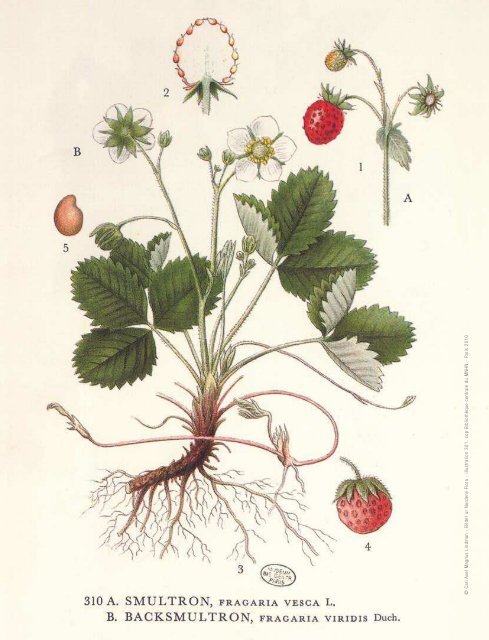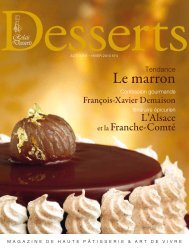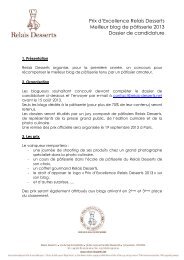Télécharger le magazine (PDF) - Relais Desserts
Télécharger le magazine (PDF) - Relais Desserts
Télécharger le magazine (PDF) - Relais Desserts
Create successful ePaper yourself
Turn your PDF publications into a flip-book with our unique Google optimized e-Paper software.
© Carl Axel Magnus Lindman - Bilder ur Nordens Flora - illustration 301. cop Bibliothèque centra<strong>le</strong> du MNHN - Paris 2010<br />
© Photos D.R.<br />
La fraise des Amériques<br />
The strawberry of the Americas<br />
Sous ses apparences tranquil<strong>le</strong>s, la fraise est une aventurière. Du moins<br />
sa grand-mère qui était une sorte de James Bond girl avant la <strong>le</strong>ttre.<br />
Beneath its tame exterior, the strawberry is an adventuress. At <strong>le</strong>ast<br />
its grandmother was… A sort of James Bond girl before her time.<br />
Mais comment ne pas trahir son pays d’origine quand on est fraise et<br />
qu’un espion de Sa Majesté (pas la reine d’Ang<strong>le</strong>terre… Louis XIV)<br />
du nom prédestiné de Frézier vous propose de <strong>le</strong> suivre de l’autre<br />
côté des océans ? Amédée François Frézier avait été envoyé par<br />
Louis XIV <strong>le</strong> long de la côte ouest de l’Amérique du Sud, pour<br />
« se renseigner » sur l’activité des colonies espagno<strong>le</strong>s.<br />
Un peu botaniste, débarqué au Chili en 1712, il y découvrit un fruit<br />
ressemblant, mais en beaucoup plus gros, à la fraise connue alors<br />
en France, cel<strong>le</strong> à petit fruit dite aujourd’hui des bois. Il en ramena<br />
quelques plants et en 1714 <strong>le</strong>s confia à Jussieu pour<br />
qu’ils entrent au Jardin du Roi, l’actuel Jardin des<br />
Plantes. C’est à partir de ces plants, hybridés avec <strong>le</strong>s<br />
variétés indigènes et une autre à gros fruits originaire<br />
d’Amérique du Nord (de Virginie), acclimatée en<br />
Ang<strong>le</strong>terre peu de temps auparavant, que sont nées<br />
<strong>le</strong>s fraises que l’on connaît aujourd’hui. L’aventurière<br />
a eu une descendance prolifique : on ne compte pas<br />
moins de six cents variétés de fraises… Des plus fades<br />
aux plus parfumées…<br />
En fait, la fraise n’est pas un fruit ! Les fruits sont <strong>le</strong>s<br />
akènes, ces petits grains qui en parsèment la surface.<br />
El<strong>le</strong>, el<strong>le</strong> n’est que <strong>le</strong> réceptac<strong>le</strong> charnu de la f<strong>le</strong>ur. La<br />
fraise aime <strong>le</strong> so<strong>le</strong>il, qui lui apporte saveur sucrée et parfum, mais pas<br />
la sécheresse : el<strong>le</strong> se plaît dans <strong>le</strong>s régions sous influences maritimes.<br />
En France, cela a fait la fortune de Plougastel où el<strong>le</strong> a été cultivée<br />
dès <strong>le</strong> XVIIIe sièc<strong>le</strong>, ou de Wépion en Belgique. En France encore,<br />
<strong>le</strong> Sud-Ouest lui convient bien, alliant cha<strong>le</strong>ur et climat océanique.<br />
La fraise est fragi<strong>le</strong> et voyage mal. La recherche agronomique a beaucoup<br />
travaillé cette question. Longtemps, cela a donné des fraises<br />
résistantes mais sans goût, dont cel<strong>le</strong>s d’Espagne restent souvent<br />
l’exemp<strong>le</strong>, malheureusement, puis <strong>le</strong>s fraises goûteuses sont revenues :<br />
la gariguette, imaginée par l’INRA aux portes d’Avignon, la mara<br />
des bois créée en Sologne par Marionnet, frère du célèbre vigneron,<br />
et bien d’autres comme l’elsanta, la ciflorette, la darse<strong>le</strong>ct, la charlotte.<br />
Toutes des variétés à gros fruit, mais <strong>le</strong>s « fraises des bois » sont<br />
toujours cultivées aussi. Leur parfum concentré est recherché pour<br />
aromatiser sorbets et entremets.<br />
par Bénédict Beaugé<br />
Amédée François Frézier<br />
Tendance Histoire<br />
—<br />
But as a strawberry, how do you avoid betraying your country when<br />
one of her majesty’s (Louis XIV that is, not the Queen of England)<br />
spies, a certain Frézier, asks you to follow him to the other side of the<br />
world? Amédée François Frézier was sent by Louis XIV on a reconnaissance<br />
mission along the west coast of South America to find out<br />
about Spanish colonial activity there.<br />
A bit of a botanist himself, on arriving in Chi<strong>le</strong> in 1712 he came<br />
across a considerably larger version of the strawberry already known<br />
at that time in France; the small fruit we now refer to as wild strawberries.<br />
He brought back a few examp<strong>le</strong>s and in 1714 entrusted<br />
them to Jussieu for him to introduce into the Jardin<br />
du Roi, now known as the Jardin des Plantes. It was<br />
from these plants, crossed with indigenous varieties<br />
and another big fruit originating from Virginia<br />
in North America and introduced in England not<br />
long beforehand, that the strawberries we know<br />
today were born. The adventuress has given rise to<br />
a prolific lineage: there are now no fewer than 600<br />
varieties of strawberry….from the most taste<strong>le</strong>ss<br />
to the most fragrant…<br />
The strawberry is not actually a fruit though! The<br />
fruits are the achenes, those litt<strong>le</strong> seeds that cover its<br />
surface. The strawberry is merely the flower’s f<strong>le</strong>shy<br />
receptac<strong>le</strong>. The strawberry likes the sun, which gives it its fragrance<br />
and sweet taste, but not dryness: it thrives in regions influenced by<br />
a maritime climate. In France, it has been the making of Plougastel,<br />
where it has been grown since the 18th century, and in Belgium in<br />
the town of Wépion. Back in France, the south-west, with its warmth<br />
and oceanic climate, is also ideal.<br />
The strawberry is fragi<strong>le</strong> and does not travel well. Agronomic<br />
research has studied this prob<strong>le</strong>m in great depth. For a long whi<strong>le</strong>,<br />
this gave rise to hardy, but taste<strong>le</strong>ss strawberries, of which Spanish<br />
ones are unfortunately the lasting examp<strong>le</strong>, before the return of the<br />
more succu<strong>le</strong>nt varieties: the gariguette, created by the INRA near<br />
Avignon, the mara des bois created in Sologne by Marionnet, brother<br />
of the famous wine-grower, and many others such as the elsanta, ciflorette,<br />
darse<strong>le</strong>ct and charlotte. All the aforementioned are large fruit<br />
varieties, but “wild strawberries” are still also grown. Their concentrated<br />
aroma is sought after for flavouring sorbets and desserts.<br />
11









